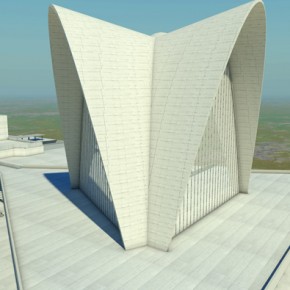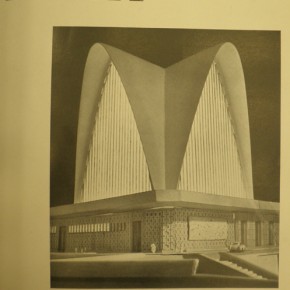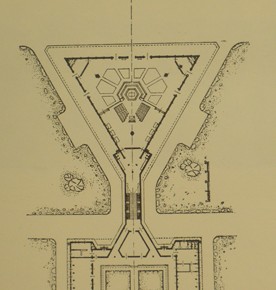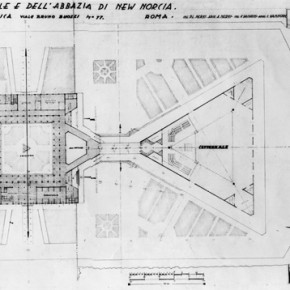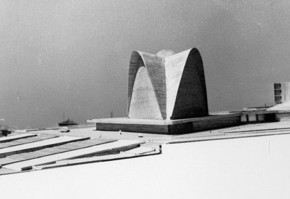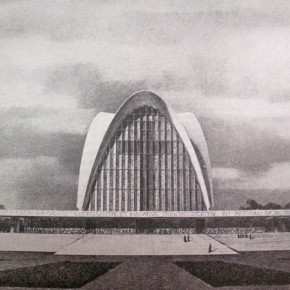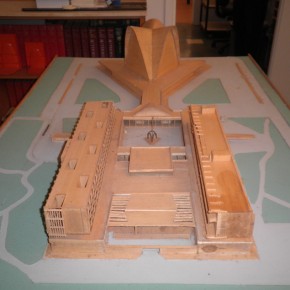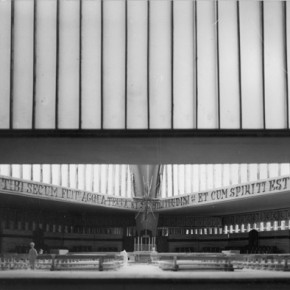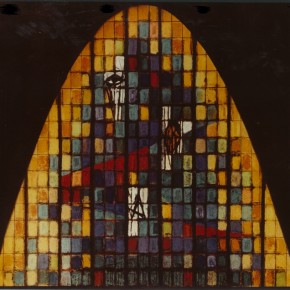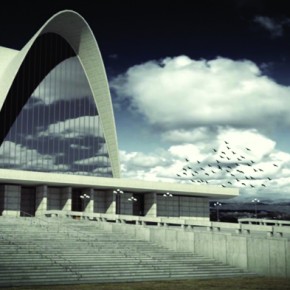- 1 – Three-dimensional animation of Nervi’s New Norcia Cathedral project, 2011. Courtesy Rene Van Meeuwen
- 2 – Cover of Australian Architecture Today, June 1960. Photo: A. Condello. National Library of Australia
- 3 – Site plan of Nervi’s scheme of the New Norcia Cathedral and Monastery. Courtesy New Norcia Archive
- 4 – Plan of the building ensemble. Courtesy New Norcia Archive
- 5 – Model of Nervi’s scheme of the New Norcia Cathedral and Monastery. In the background is a view of a Roman rooftop. Courtesy New Norcia Archive
- 6 – Elevation of Nervi’s scheme of the New Norcia Cathedral and Monastery. Courtesy New Norcia Archive
- 7 – Nervi’s original model. Courtesy New Norcia Archive. Photo: Annette Condello
- 8 – Interior of original model. Courtesy New Norcia Archive
- 9 – Willy Kaufman, Art glass design. Courtesy New Norcia Archive
- 10 – Three-dimensional animation of Nervi’s New Norcia Cathedral and Monastery project, 2011. Courtesy Rene Van Meeuwen
This essay analyses Pier Luigi Nervi’s New Norcia Cathedral and Monastery scheme (1957-1961), an unrealized project near Perth, Western Australia. This particular scheme directed Australian attention to the Italian’s work, later leading to Nervi’s involvement with the design of Australia’s first reinforced concrete skyscraper, Australia Square Tower (1967) in Sydney, designed in collaboration with Australian architect Harry Seidler. It argues that Nervi’s work introduced Italian modernism to Australia – mediated by his experiences in Latin America.
In the nineteen thirties, Italy and the Americas in particular became loci for strong cultural exchanges. Mass migration of architects and engineers from Italy (and elsewhere) to the Unites States and Latin America gave rise to a new fervour for inspirational forms. Italian architects, such as Marcello Piacentini, Pier Luigi Nervi and Lina Bo Bardi, would work in or visit this Latin America, merging their ideas with the indigenous forms they encountered there. Others, such as Italian-American-Australian architect Romaldo Giurgola vicariously gained inspiration from their exploratory travels. (1)
Around 1937, Pier Luigi Nervi secured a position in working with Italian Rationalist Marcello Piacentini on the E 42 project, specifically the Palazzo dell’acqua e delle luce, Exhibition Halls A and B with Pietro Maria Bardi. After this experience, Nervi next developed the construction method for a Monumental Arch designed by Adalberto Libera, resembling an aircraft hangar. (2) In effect, Piacentini noted that, “Rationalism coincided not with Fascism but with Internationalism.” (3) In the nineteen thirties, the Brazilian government invited Piacentini to Brazil as a consultant by the Rio de Janeiro government to consult on their project to construct a Cuidade Universita (unrealized). Italian Rationalism would now mingle with Internationalism. By 1933 Internationalism was already part of Pietro Maria Bardi’s larger agenda. Bardi departed Italy in the late nineteen forties temporarily to establish a Museum of Modern Art in Rio de Janeiro, Brazil. Nervi’s success in Brazil (and earlier in Argentina) led to commissions in Venezuela, the United States and as far south as Australia.
Latin American architects took the 1939 New York’s World Fair as an important opportunity to expose their intercontinental designs. Oscar Niemeyer and Lucio Costa’s Brazil Pavilion (1939-40) spell-bounded visitors with its fluid spaces, pool, and Roberto Burle Marx’s tropical garden in its internal court. The Brazilian Pavilion impacted the way architects from foreign countries might import Internationalist trends by embodying elements, such as the fluid spaces and elevated platforms, into their designs. Interestingly, “Australia and Brazil converged at the 1939 World’s Fair,” (4) with their pavilions nearby one another. This is the first time we see the ingress of modern Brazilian designs in Australia.
Meanwhile, a decade after the initiation of Bardi’s Brazilian museum project, he and his wife left post-war Italy and settled in Rio de Janeiro. In 1951, the Bardis were living in Sao Paulo and they invited Nervi to “spend a few weeks” with them to lecture on his concrete structures at the São Paolo Art Museum (MASP), designed by Lina Bo Bardi. (5) There, Nervi and his son Antonio collaborated with Bo Bardi on the Taba Guaianazes complex (1954). (6) Although the multi-storey project was unrealized, it provided Nervi with the opportunity to observe other Latin American structures then under construction (which presumably later inspired the Pirelli Tower design in Milan). Castro Mello’s Covered Swimming Pool (1948-52) at São Paolo, for instance, with its parabolic arches is one obvious structure. Parabolic arches would soon become a kind of trademark throughout central and southern Latin America. Earlier in Mexico, for instance, Enrique de la Mora’s Purisima Church (1939-1943) and Felix Candela’s Cosmic Ray Pavilion (1951-52) offered inspiration. Presumably Castro Mello’s Brazilian pool was of importance to Nervi’s career as far as a Latin American source is concerned – his Italian works were informed by his Brazilian experience. (7) This experience, in turn, impacted his skyscraper designs with Harry Seidler in Sydney in 1967. More importantly shell structures such as Nervi’s were popular in the nineteen forties and fifties, especially in Europe and Latin America.
Such Latin American links would surely increase Nervi’s aspiration to further disseminate ideas of reinforced concrete parabolas to Australia. Nervi’s work prospects veered off in a different direction in the nineteen fifties – to build taller reinforced concrete structures in Australia. Previously, he had spent at least thirty years of his career as a sought-after engineer, then as an architect. (image 2.)
In 1957, Nervi was commissioned to design a Roman Catholic Cathedral and Monastery in a rather surprising location: New Norcia in rural Western Australia. Although it would never be realized, Nervi’s design accelerated architectural sensation in Australia and overseas. Domestically, for instance, Australian Architecture Today devoted its June 1960 feature article to “Australia’s first Nervian structure” and illustrated the cathedral on its cover; Building: Lighting: Engineering followed the next month. Overseas, it won published accolades in New York and Nervi’s native Italy. Today, however, Nervi’s New Norcia project remains but a one-off reference (or image) within his wider architectural oeuvre. (8) As scholars have recently begun to re-evaluate Nervi’s production, it is timely to re-illuminate his little known proposal for a remote, arid landscape, a hemisphere removed from its source.
Founded in 1847, New Norcia is a Benedictine Order town in Western Australia that evolved architecturally through time. Sited on the Victoria Plains and widely recognised as Australia’s only monastic township, it is placed in a gentle valley on the banks of the Moore River. The name “New Norcia” is derived from that of the Order’s founder, Saint Benedict of Nursia (San Benedetto da Norcia; c 480-547), and the town Norcia, in Perugia, Italy. (9) Now New Norcia is a comfortable 1.5 hour drive along Northern Highway, north-east of Perth: one could imagine that in 1957 the trek would have required considerably more time. Had Nervi’s modernist cathedral and monastery been erected, it would have heightened the archaic-ness of its nineteenth century architectural surrounds.
Nervi’s project was one outcome of Abbot Gomez’s desire to make New Norcia a pilgrimage site. With the Second World War’s approach, building efforts to improve the town came to a halt. Yet after the war, a pilgrim peace tour of the statue of the Lady of Fatima (from Portugal) was made throughout the Catholic world in 1951. The entourage sailed via India and Vietnam and eventually reached the Western Australia port at Fremantle. From there, “the statue was taken in procession from Bindoon to New Norcia.” (10) The procession culminated at the monastery grounds, which would prove too congested to accommodate large crowds. Later in the same year, Dr Gregory Gomez was appointed Abbot of New Norcia. Celebration of the event was held out-of-doors as the existing church was not large enough, requiring construction of “special altars” out-of-doors. (11) Consequently, Abbot Gomez now sought to commission an architect to design a new cathedral and monastery for New Norcia; the town was poised to become a tourist destination.
In 1957, Abbot Gomez solicited the International Institute for Liturgical Art (Istituto Internazionale di Arte Liturgica) in Rome for a New Norcia Cathedral and Monastery design. Founded the previous year, the organisation facilitated construction of new churches, in, for instance, Brazil, The Philippines and now Western Australia, and aimed “to safeguard and harmonise liturgical and artistic values.” (12) The organisation recommended architect Carlo Vannoni and Nervi to Gomez.
New Norcia’s Cathedral and Monastery was not Nervi’s first ecclesiastical work. Earlier he served as structural engineer for the roof of Breuer’s Benedictine Abbey Church of Saint John’s at Collegeville, Minnesota (1953-61), the Cuore Immacolato di Maria Church (1955-62) in Bologna (designed with Giuseppe Vaccaro), and the Underground Catholic Basilica of Lourdes (completed in 1958), France (designed with Pierre Vago). The pilgrimage site of Lourdes became the main touchstone from which Nervi’s architectural career was to impact Western Australia. Consequently, Nervi was an apt choice as the Benedictine Order’s main designer for Australia. (image 3.-4 – 5)
New Norcia’s archive includes the Institute’s report entitled Progetto della Cattedrale dedicate alla Santissima Trinita e Annesso Monastero (Cathedral Project dedicated to the Holy Trinity and Adjacent Monastery). This document explains the buildings’ religious symbolism, lists the project requirements, and reproduces some of the drawings of the building ensemble. The project was to be sited to the west, cross axial to the town itself, on sloping ground where the cemetery exists today. This site, in reality, seems far too constricted: the rationale for its selection is unclear. The model features two staircases, facing a large square and beyond this is the location of the cathedral and monastery. The plan shows only one staircase in front of the cathedral. Nonetheless, the cathedral design itself has a seating capacity of 820 people and standing room for about 1000 people – a total of over 1800. Three parabolic arches atop an equilateral triangle face outwards on the sides of the cathedral with an altar in the centre. The height from the base of the church to the centre of the cupola is 38 metres. Behind the cathedral is the three-storey monastery in which the total surface is 7200 metres with 114 cells for Benedictine Monks, including two rooms for guests. Nervi collaboratively produced the design with his son architect Antonio Nervi, engineer Francesco Vacchini and the Institute’s architect Carlo Vannoni. (13) Apparently, Nervi and his son were responsible for the Cathedral design, Vannoni and Vacchini for the Monastery. (14) The project was, and still is, significant and well-advanced for its time as it demonstrates an Italian Rationalist trend via Latin America. Uncannily, Nervi’s siting of the project recalls a fragment from Lucio Costa’s Pilot Plan for of Brasilia competition (1957). (image 6 – 7)
The first public mention of the project in Australia was made in 1959. That May, a Melbourne newspaper The Age reported that “the International Institute for Liturgical Art had approved a design by Signor Nervi” (15) and that construction was to begin on the cathedral later in the year. Other New Norcian archival records include Nervi’s working drawings and details for the seating design and parabolic halo-shaped windows and models, produced in Rome. Around the same time when the Palace of Labour structure was designed by Nervi himself, his son Antonio and Gino Covre, it appears as though the New Norcia cathedral interior was informed by the work of Gio Ponti. Though working drawings were completed, (16) the only works executed for the cathedral was the bronze entry doors and stained glass work (17) designed by a Swiss artist Willy Kaufman. The window designs within the parabolic arches resemble the work of Marc Chagall; the windows apparently were manufactured in Rome and remain in storage at the Vatican. (imagr 8 – 9)
How did the cathedral and monastery ensemble “fit” within the existing compound? Despite the architects’ Modernist aesthetic, the buildings are not without historical reference. Most notably, the monastery is organized in the medieval cloister configuration. This might have been Vannoni’s decision, not Nervi’s.
Overall, Nervi’s scheme is rational, quasi-“Sant’Elian.” His cathedral, for instance, resembles Antonio Sant’Elia’s Study for a church (1915). (18) At New Norcia, Nervi substitutes a flush arched façade with three parabolic arches in a triangular form. After studying Nervi’s written report and model(s), Abbott Gomez accepted the glamorous three-pronged-parabola design; he was now ready to contemplate construction. Undoubtedly, the development of Nervi’s quasi-futuristic cathedral was not only influenced by his Italian experiences but also by his time in Latin America (especially since Filippo Tommaso Marinetti tried to indoctrinate Brazilians with his Futurist writings in the nineteen twenties).
Nervi, working at a distance in Rome, inevitably required a local Australian collaborator. Ostensibly owing to his civil engineering expertise, Italian/Australian academic George Hondros (1920-1966) was soon included with the cathedral project. Travelling to Rome to see a structural engineering exhibition in 1961/62, Hondros also met with Nervi. (19) He reported that the “Italians were impressed by what Hondros and the Abbot told them about Western Australia’s knowledge of building construction.” (20) According to the Australian engineer, at New Norcia “all material and labour will be Australian except the dome which will be built in Italy and shipped here.” (21) Shipping the weighty concrete parabolas in delicate prefabricated pieces from Rome to Western Australia would have been an extreme feat. Hondros and his entourage of Perth engineers would have prepared drawings in compliance with building codes, which were surely different from those of Europe and the Americas.
Nervi’s design of the parabolic cathedral was ahead of its time, informed by the modern architectural design trends of Europe and Latin America. Nervi’s model of the cathedral appears as a cosmic building that radiates “rational halos” in parabolic forms. Nervi’s Holy Trinity inspiration might have been derived from the place where Saint Benedict lived – in a cave with a triangular-shaped opening – now recognised as the Sacro Speco “Holy Cave.” (22) Nervi increased the scale of the parabolic halos to match with the vastness of the West Australian plains.
As the project reached the working drawings stage, one wonders why the project failed to materialise. How did the Benedictine Order in outback Western Australia, presumably of modest financial means, hope to fund the surrealistically monumental project’s construction? Shortly after Nervi completed his design, one newspaper account (c 1960) estimated construction cost to be ‘near to’ 500,000 pounds (equivalent today to 1 million Australian dollars). The project was made “a possibility in the near future,” the report explained, “by the proposed [Benedictine Order’s] sale of five acres of land in East Perth.” (23) “Money from the land sale” of the cleared blocks in East Perth was “to be used to build the new cathedral at new Norcia.” (24) Construction was to be contingent upon the sale yielding “about 300,000 pounds” (600,000 dollars). Perplexingly, the newspaper also reported that the future cathedral’s “bronze doors, altars, and stained glass windows” had already “been completed” in Italy, in advance of the land sale. According to Australian Architecture Today (1960), the project’s estimated cost had soon escalated to 800,000 pounds (1.6 million dollars), prompting the launch of an appeal to “generous Australians” for contributions toward construction. It is unclear as to whether or not the East Perth land sale went ahead. Presumably by the end of 1961, the project to build the cathedral and the monastery had stalled. In the end, sufficient funding could not be raised. Perhaps they did not realise what the anticipated land sale price was.
Although Nervi’s New Norcia Cathedral and Monastery project remained but a vision on paper, his West Australian commission served to attract Australian professional attention to his work. He later contributed to the realization of Australia’s first reinforced concrete skyscraper, a cylindrical tower named Australia Square (1961-1967) with Harry Seidler, in Sydney. Following this project Nervi contributed to the MLC Centre (1975), also in Sydney. Later in Perth, Seidler’s design of the QVI Tower (1987-91) derived its structural concrete lessons from Nervi’s “V” skyscraper plan form. Perhaps Nervi’s early working relationship with Piacentini, the Bardis in Italy and Brazil implanted an Italian/Latin American urban-type in a remote part of Australia. One might detect this implantation not only in New Norcia or the work of Seidler in Sydney but also in the work of Romaldo Giurgola in Canberra. Recently, Nervi’s Cathedral and Monastery project has been superbly resurrected in three-dimensional animation. (25)
Notes:
(1) Romaldo Giurgola, who earlier worked under Nervi, later designed a structure in Brasilia and Australia’s Parliament House in Canberra. Giurgola was taught by Piacentini, knew both Lina Bo and her husband Pietro Maria Bardi and witnessed talks by Filippo Tommaso Marinetti in Rome (as stated in a conversation I had with him at his home in Canberra, January 18, 2012). Stephen Frith noted how Romaldo worked under Nervi in “Aldo in Rome: the early years,” presented at The Reluctant Master: a symposium to honour the life and work of Romaldo Giurgola, The University of Melbourne, August 20, 2011. Thanks to Christopher Vernon for his comments.
(2) Tullia Iori, Pier Luigi Nervi, Milan: Motta Architettura, 2009, p.29.
(3) Dennis Doordan, Building Modern Italy: Italian Architecture 1914-1936, New York, 1988, p.90. Also see Terry Kirk, The Architecture of Modern Italy, Volume II. Visions of Utopia, 1900-Present, New York: Princeton Architectural Press, 2005, pp.81-83.
(4) Christopher Vernon, “A Southern Design Dialogue,” in Architecture Australia, September/October 2010, P.33.
(5) Zeuler Lima, “Nelson A. Rockerfeller and Art Patronage in Brazil after World War II: Assis Chateaubriand,” The Museo de Arte Moderna (MAM), the Rockerfeller Archive Centre-Research Report, 2010. Thanks to Zeuler for granting me permission to use this report.
(6) See Lina Bo Bardi, “Taba Guaianases,” in Habitat, No.14, January-February, 1954: 4-10.
(7) In Italy Nervi designed the swimming pool at Livorno Naval Academy in 1949. Refer to Tullia Iori, Pier Luigi Nervi, Milan: Motta Architettura, 2009, p.30. Another pool was planned for Milan. See Carlo Olmo and Cristiana Chiorino (eds.), Pier Luigi Nervi: Architecture as Challenge, Milano: Silvana Editoriale, 2010, p.217.
(8) See Carlo Olmo and Cristiana Chiorino (eds.), Pier Luigi Nervi: Architecture as Challenge, Milano: Silvana Editoriale, 2010, p.218; and Tullia Iori, Pier Luigi Nervi, Milan: Motta Architettura, 2009, pp.30, 114.
(9) Originally, New Norcia’s valley was called Maura Maura. “The Romance of Australian Place Names,” The Australian Women’s Weekly, Wednesday 13 May, 1964, p.61.
(10) “Archdeacon Challenges Belief in a Statue,” The West Australian Newspaper, Monday 15 January, 1951, p.7.
(11) “Church History at New Norcia,” The West Australian Newspaper, Monday 8 October, 1951, p.2.
(12) “Australia’s First Nervian Structure,” in Australian Architecture Today, June 1960, Vol. 2, 1959/60, p.16. Also see “New Cathedral for New Norcia,” Building, Lighting, Engineering, July 1960, pp.25-26, 41.
(13) Refer to “Australia’s First Nervian Structure,” in Australian Architecture Today, June 1960, Vol. 2, 1959/60, p.13.
(14) See John White, “Pier Luigi Nervi and the Design for a New Cathedral,” in A Town Like No Other: The Living Tradition of New Norcia, ed. David Hutchinson, Fremantle Arts Centre Press, 1995, p.123.
(15) “Italian Design WA Cathedral,” The Age, Melbourne, Tuesday May 1959, p.4.
(16) “Australia’s First Nervian Structure,” in Australian Architecture Today, June 1960, Vol. 2, 1959/60, p.16.
(17) “Cathedral a major work of art,” c 1960, newspaper title unknown. Also see Kevin Smith, ‘Cathedral for Australia,’ The Herald, August 20, 1960, p.26.
(18) Refer to Esther da Costa Meyer, The Work of Antonio Sant’Elia: Retreat into the Future, 1995, New Haven and London: Yale University Press, 1995, Plate 63, p.70 and Plate 21, p.132.
(19) Email-correspondence with Jack Hondros, Perth, 29 and 31 January, and 2 February, 2012.
(20) “Cathedral a major work of art,” c 1960, newspaper title unknown.
(21) Ibid.
(22) The Oxford Companion to Christian Art and Architecture, Oxford and New York: Oxford University Press, 1996, p.51.
(23) “Cathedral a major work of art,” c 1960, newspaper title unknown.
(24) Ibid.
(25) A version of my essay on Pier Luigi Nervi’s Cathedral for New Norcia was presented at the Unbuilt Perth Symposium, 10 March 2012 at the Faculty of Architecture, Landscape and Visual Arts, The University of Western Australia. Refer to three-dimensional animations created by Keith Reid and Scott Horsburgh and see Annette Condello “Pier Luigi Nervi’s Cathedral and Monastery for New Norcia (1957-1961)” in Rene Van Meeuwen, Unbuilt Perth catalogue, The Faculty of Architecture, Landscape and Visual Arts, The University of Western Australia, March 2012, pp.8-17, 18-23.





